Designing and Implementing an Azure AI Solution v1.0
Question 1
You deploy an application that performs sentiment analysis on the data stored in Azure Cosmos DB.
Recently, you loaded a large amount of data to the database. The data was for a customer named Contoso, Ltd.
You discover that queries for the Contoso data are slow to complete, and the queries slow the entire application.
You need to reduce the amount of time it takes for the queries to complete. The solution must minimize costs.
What should you do? More than one answer choice may achieve the goal. (Choose two.)
- A. Change the request units.
- B. Change the partitioning strategy.
- C. Change the transaction isolation level.
- D. Migrate the data to the Cosmos DB database.
Answer : AB
Explanation:
Increasing request units would improve throughput, but at a cost.
Throughput provisioned for a container is divided evenly among physical partitions.
References:
https://docs.microsoft.com/en-us/azure/architecture/best-practices/data-partitioning
Question 2
Your company has several AI solutions and bots.
You need to implement a solution to monitor the utilization of the bots. The solution must ensure that analysts at the company can generate dashboards to review the utilization.
What should you include in the solution?
- A. Azure Application Insights
- B. Azure Data Explorer
- C. Azure Logic Apps
- D. Azure Monitor
Answer : A
Explanation:
Bot Analytics.
Analytics is an extension of Application Insights. Application Insights provides service-level and instrumentation data like traffic, latency, and integrations. Analytics provides conversation-level reporting on user, message, and channel data.
References:
https://docs.microsoft.com/en-us/azure/bot-service/bot-service-manage-analytics
Question 3
Your plan to design a bot that will be hosted by using Azure Bot Service.
Your company identifies the following compliance requirements for the bot:
✑ Payment Card Industry Data Security Standards (PCI DSS)
✑ General Data Protection Regulation (GDPR)
✑ ISO 27001
You need to identify which compliance requirements are met by hosting the bot in the bot service.
What should you identify?
- A. PCI DSS only
- B. PCI DSS, ISO 27001, and GDPR
- C. ISO 27001 only
- D. GDPR only
Answer : B
Explanation:
Azure Bot service is compliant with ISO 27001:2013, ISO 27019:2014, SOC 1 and 2, Payment Card Industry Data Security Standard (PCI DSS), and Health
Insurance Portability and Accountability Act Business Associate Agreement (HIPAA BAA).
Microsoft products and services, including Azure Bot Service, are available today to help you meet the GDPR requirements.
References:
https://docs.microsoft.com/en-us/azure/bot-service/bot-service-compliance https://blog.botframework.com/2018/04/23/general-data-protection-regulation-gdpr/
Question 4
HOTSPOT -
You plan to use Azure Cognitive Services to provide the development team at your company with the ability to create intelligent apps without having direct AI or data science skills.
The company identifies the following requirements for the planned Cognitive Services deployment:
✑ Provide support for the following languages: English, Portuguese, and German.
✑ Perform text analytics to derive a sentiment score.
Which Cognitive Service service should you deploy for each requirement? To answer, select the appropriate options in the answer area.
NOTE: Each correct selection is worth one point.
Hot Area:
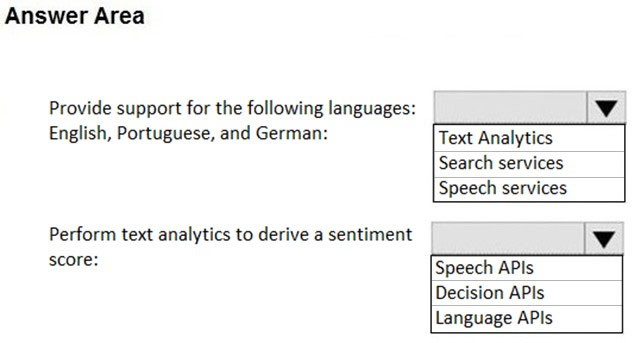
Answer : 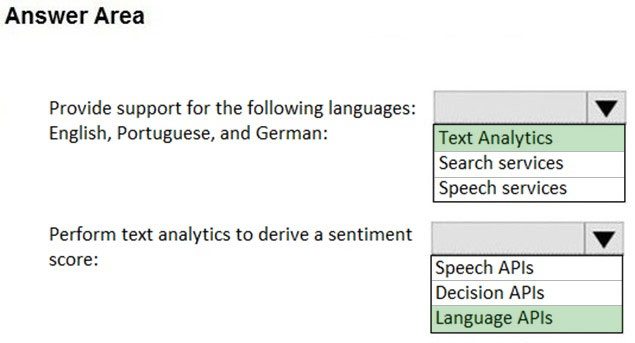
Explanation:
Box 1: Text Analytics -
The Language Detection feature of the Azure Text Analytics REST API evaluates text input for each document and returns language identifiers with a score that indicates the strength of the analysis.
Box 2: Language API -
References:
https://docs.microsoft.com/en-us/azure/cognitive-services/text-analytics/how-tos/text-analytics-how-to-language-detection https://docs.microsoft.com/en-us/azure/azure-databricks/databricks-sentiment-analysis-cognitive-services
Question 5
HOTSPOT -
You plan to deploy the Text Analytics and Computer Vision services. The Azure Cognitive Services will be deployed to the West US and East Europe Azure regions.
You need to identify the minimum number of service endpoints and API keys required for the planned deployment.
What should you identify? To answer, select the appropriate options in the answer area.
NOTE: Each correct selection is worth one point.
Hot Area:
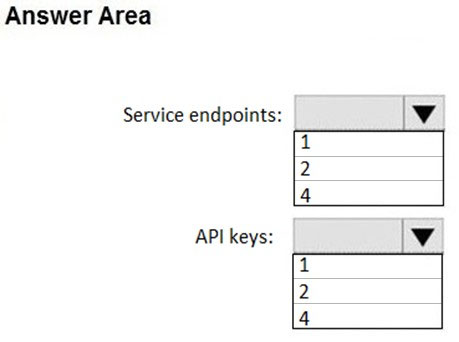
Answer : 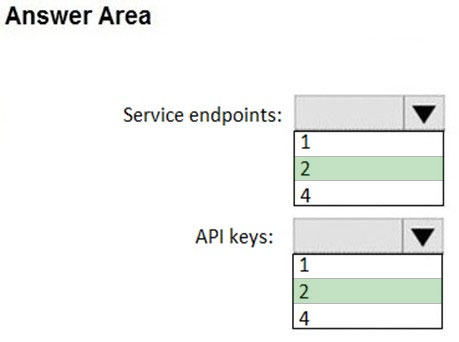
Explanation:
Box 1: 2 -
After creating a Cognitive Service resource in the Azure portal, you'll get an endpoint and a key for authenticating your applications. You can access Azure
Cognitive Services through two different resources: A multi-service resource, or a single-service one.
Multi-service resource: Access multiple Azure Cognitive Services with a single key and endpoint.
Note: You need a key and endpoint for a Text Analytics resource. Azure Cognitive Services are represented by Azure resources that you subscribe to.
Each request must include your access key and an HTTP endpoint. The endpoint specifies the region you chose during sign up, the service URL, and a resource used on the request
Box 2: 2 -
You need at least one key per region.
References:
https://docs.microsoft.com/en-us/azure/cognitive-services/cognitive-services-apis-create-account
Question 6
Your company plans to create a mobile app that will be used by employees to query the employee handbook.
You need to ensure that the employees can query the handbook by typing or by using speech.
Which core component should you use for the app?
- A. Language Understanding (LUIS)
- B. QnA Maker
- C. Text Analytics
- D. Azure Search
Answer : D
Explanation:
Azure Cognitive Search (formerly known as "Azure Search") is a search-as-a-service cloud solution that gives developers APIs and tools for adding a rich search experience over private, heterogeneous content in web, mobile, and enterprise applications. Your code or a tool invokes data ingestion (indexing) to create and load an index. Optionally, you can add cognitive skills to apply AI processes during indexing. Doing so can add new information and structures useful for search and other scenarios.
Incorrect Answres:
B: QnA Maker is a cloud-based API service that lets you create a conversational question-and-answer layer over your existing data. Use it to build a knowledge base by extracting questions and answers from your semi-structured content, including FAQs, manuals, and documents. Answer usersג€™ questions with the best answers from the QnAs in your knowledge baseג€"automatically.
References:
https://docs.microsoft.com/en-us/azure/search/search-what-is-azure-search
Question 7
You have an existing Language Understanding (LUIS) model for an internal bot.
You need to recommend a solution to add a meeting reminder functionality to the bot by using a prebuilt model. The solution must minimize the size of the model.
Which component of LUIS should you recommend?
- A. domain
- B. intents
- C. entities
Answer : C
Explanation:
LUIS includes a set of prebuilt entities for recognizing common types of information, like dates, times, numbers, measurements, and currency. Prebuilt entity support varies by the culture of your LUIS app.
Note: LUIS provides three types of prebuilt models. Each model can be added to your app at any time.
Model type: Includes -
✑ Domain: Intents, utterances, entities
✑ Intents: Intents, utterances
✑ Entities: Entities only
References:
https://docs.microsoft.com/en-us/azure/cognitive-services/luis/luis-concept-prebuilt-model
Question 8
You have an on-premises repository that contains 5,000 videos. The videos feature demonstrations of the products sold by your company.
The companyג€™s customers plan to search the videos by using the name of the product demonstrated in each video.
You need to build a custom search tool for the customers.
What should you do first?
- A. Deploy an Azure Media Services resource.
- B. Create an Azure Storage account and a blob container.
- C. Create an Azure Search resource.
- D. Deploy a Custom Vision API service.
Answer : A
Explanation:
Azure Media Services can be used to encode and package content, stream videos on-demand, broadcast live, analyze your videos with Media Services v3.
You can snalyze recorded videos or audio content. For example, to achieve higher customer satisfaction, organizations can extract speech-to-text and build search indexes and dashboards. Then, they can extract intelligence around common complaints, sources of complaints, and other relevant data.
References:
https://docs.microsoft.com/en-us/azure/media-services/latest/media-services-overview
Question 9
Your company manages a sports team.
The company sets up a video booth to record messages for the team.
Before replaying the messages on a video screen, you need to generate captions for the messages and check the sentiment of the video to ensure that only positive messages are played.
Which Azure Cognitive Services service should you use?
- A. Language Understanding (LUIS)
- B. Speaker Recognition
- C. Custom Vision
- D. Video Indexer
Answer : D
Explanation:
Video Indexer includes Audio transcription: Converts speech to text in 12 languages and allows extensions. Supported languages include English, Spanish,
French, German, Italian, Mandarin Chinese, Japanese, Arabic, Russian, Portuguese, Hindi, and Korean.
When indexing by one channel, partial result for those models will be available, such as sentiment analysis: Identifies positive, negative, and neutral sentiments from speech and visual text.
Reference:
https://docs.microsoft.com/en-us/azure/media-services/video-indexer/video-indexer-overview
Question 10
HOTSPOT -
You plan to build an app that will provide users with the ability to dictate messages and convert the messages into text.
You need to recommend a solution to meet the following requirements for the app:
✑ Must be able to transcribe streaming dictated messages that are longer than 15 seconds.
✑ Must be able to upload existing recordings to Azure Blob storage to be transcribed later.
Which solution should you recommend for each requirement? To answer, select the appropriate options in the answer area.
NOTE: Each correct selection is worth one point.
Hot Area:
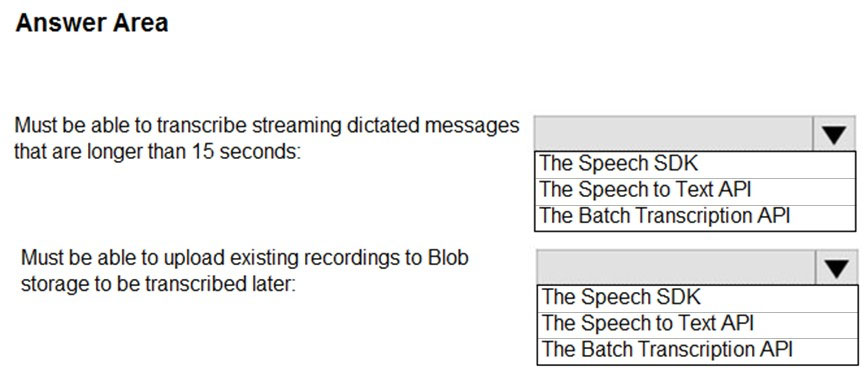
Answer : 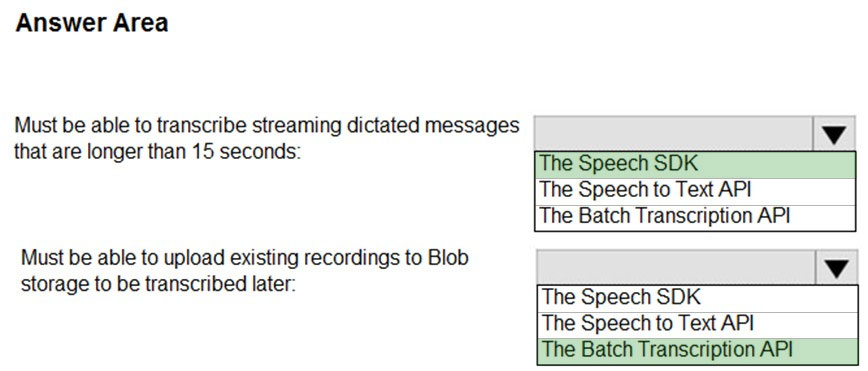
Explanation:
Box 1: The Speech SDK -
The Speech SDK is not limited to 15 seconds.
Box 2: Batch Transcription API -
Batch transcription is a set of REST API operations that enables you to transcribe a large amount of audio in storage. You can point to audio files with a shared access signature (SAS) URI and asynchronously receive transcription results. With the new v3.0 API, you have the choice of transcribing one or more audio files, or process a whole storage container.
Asynchronous speech-to-text transcription is just one of the features.
Reference:
https://github.com/Azure-Samples/cognitive-services-speech-sdk/issues/13 https://docs.microsoft.com/en-us/azure/cognitive-services/speech-service/batch-transcription
Question 11
Your company plans to monitor twitter hashtags, and then to build a graph of connected people and places that contains the associated sentiment.
The monitored hashtags use several languages, but the graph will be displayed in English.
You need to recommend the required Azure Cognitive Services endpoints for the planned graph.
Which Cognitive Services endpoints should you recommend?
- A. Language Detection, Content Moderator, and Key Phrase Extraction
- B. Translator Text, Content Moderator, and Key Phrase Extraction
- C. Language Detection, Sentiment Analysis, and Key Phase Extraction
- D. Translator Text, Sentiment Analysis, and Named Entity Recognition
Answer : C
Explanation:
Sentiment analysis, which is also called opinion mining, uses social media analytics tools to determine attitudes toward a product or idea.
Translator Text: Translate text in real time across more than 60 languages, powered by the latest innovations in machine translation.
The Key Phrase Extraction skill evaluates unstructured text, and for each record, returns a list of key phrases. This skill uses the machine learning models provided by Text Analytics in Cognitive Services.
This capability is useful if you need to quickly identify the main talking points in the record. For example, given input text "The food was delicious and there were wonderful staff", the service returns "food" and "wonderful staff".
Reference:
https://docs.microsoft.com/en-us/azure/cognitive-services/text-analytics/how-tos/text-analytics-how-to-entity-linking https://docs.microsoft.com/en-us/azure/search/cognitive-search-skill-keyphrases
Question 12
HOTSPOT -
You plan to create an intelligent bot to handle internal user chats to the help desk of your company. The bot has the following requirements:
✑ Must be able to interpret what a user means.
✑ Must be able to perform multiple tasks for a user.
Must be able to answer questions from an existing knowledge base.

You need to recommend which solutions meet the requirements.
Which solution should you recommend for each requirement? To answer, drag the appropriate solutions to the correct requirements. Each solution may be used once, more than once, or not at all. You may need to drag the split bar between panes or scroll to view content.
NOTE: Each correct selection is worth one point.
Hot Area:
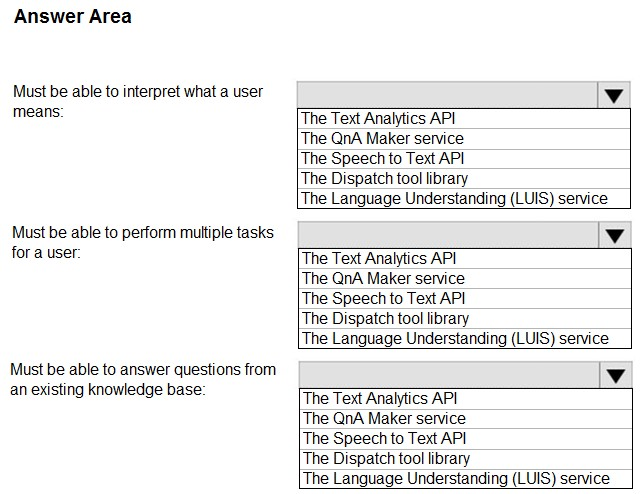
Answer : 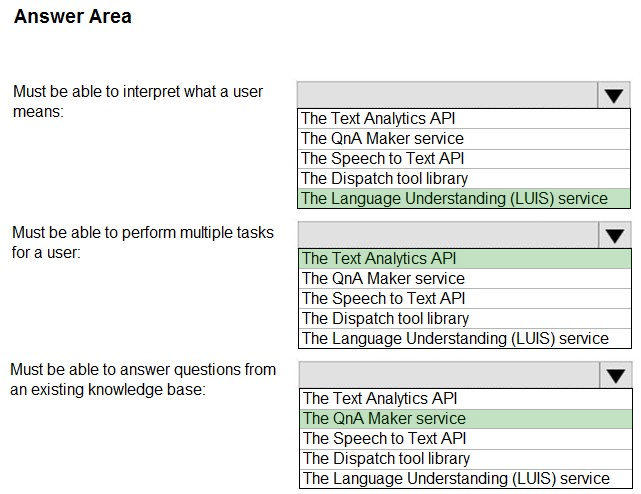
Explanation:
Box 1: The Language Understanding (LUIS) service
Language Understanding (LUIS) is a cloud-based API service that applies custom machine-learning intelligence to a user's conversational, natural language text to predict overall meaning, and pull out relevant, detailed information.
Box 2: Text Analytics API -
The Text Analytics API is a cloud-based service that provides advanced natural language processing over raw text, and includes four main functions: sentiment analysis, key phrase extraction, named entity recognition, and language detection.
Box 3: The QnA Maker service -
QnA Maker is a cloud-based Natural Language Processing (NLP) service that easily creates a natural conversational layer over your data. It can be used to find the most appropriate answer for any given natural language input, from your custom knowledge base (KB) of information.
Incorrect Answers:
Dispatch tool library:
If a bot uses multiple LUIS models and QnA Maker knowledge bases (knowledge bases), you can use Dispatch tool to determine which LUIS model or QnA Maker knowledge base best matches the user input. The dispatch tool does this by creating a single LUIS app to route user input to the correct model.
Reference:
https://docs.microsoft.com/en-us/azure/bot-service/bot-builder-tutorial-dispatch https://docs.microsoft.com/en-us/azure/cognitive-services/qnamaker/overview/overview
Question 13
You are developing a mobile application that will perform optical character recognition (OCR) from photos.
The application will annotate the photos by using metadata, store the photos in Azure Blob storage, and then score the photos by using an Azure Machine
Learning model.
What should you use to process the data?
- A. Azure Event Hubs
- B. Azure Functions
- C. Azure Stream Analytics
- D. Azure Logic Apps
Answer : D
Question 14
You are designing an AI solution that will analyze millions of pictures by using Azure HDInsight Hadoop cluster.
You need to recommend a solution for storing the pictures. The solution must minimize costs.
Which storage solution should you recommend?
- A. Azure Table storage
- B. Azure File Storage
- C. Azure Data Lake Storage Gen2
- D. Azure Databricks File System
Answer : C
Explanation:
Azure Data Lake Store is optimized for storing large amounts of data for reporting and analytical and is geared towards storing data in its native format, making it a great store for non-relational data.
Reference:
https://stackify.com/store-data-azure-understand-azure-data-storage-options/
Question 15
You are designing a real-time speech-to-text AI feature for an Android mobile app. The feature will stream data to the Speech service.
You need to recommend which audio format to use to serialize the audio. The solution must minimize the amount of data transferred to the cloud.
What should you recommend?
- A. MP3
- B. WAV/PCM
- C. MP4a
Answer : B
Explanation:
Currently, only the following configuration is supported:
Audio samples in PCM format, one channel, 16 bits per sample, 8000 or 16000 samples per second (16000 or 32000 bytes per second), two block align (16 bit including padding for a sample).
Reference:
https://docs.microsoft.com/en-us/azure/cognitive-services/speech-service/how-to-use-audio-input-streams